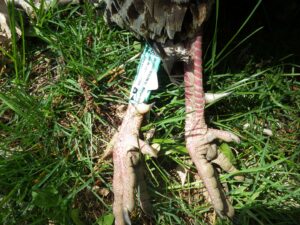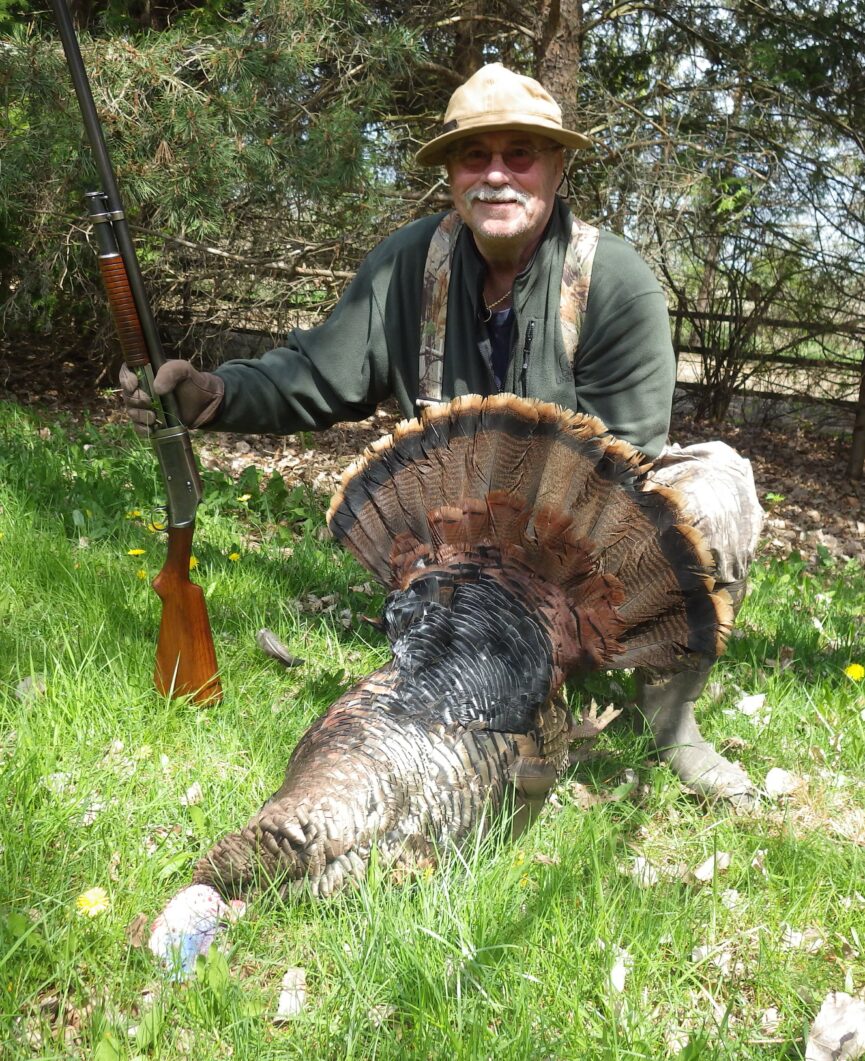
By: Tom Lounsbury.
Having been an avid Michigan spring turkey hunter for over 50 years, I’ve been able to witness how this popular pastime has evolved, with the steadily increasing wild turkey numbers which have successfully extended their territory, as well as the hunting equipment, including calls, specialized ammunition and shotgun chokes. Some of the rules have changed as well, such as the most recent which allows turkey hunters on private property to be able to use shotguns from an elevated platform or tree-stand.
Because I often like a change of scenery in our great state, I was really pleased with the over the counter 0234 turkey license, which allows me to hunt local turkeys in the Thumb on private land, and also on public lands “up north”, during most of the month of May.
Time sure flies because I can remember my first spring turkey season quite vividly, almost like it was yesterday. Probably because it was a special moment in time, and I had been fortunately drawn for a very limited spring turkey hunt in northern Michigan during a time when turkey hunting in this state was in its pioneering stages. The wild turkey had been successfully reintroduced to several areas up north and the bird population had reached a point where state wildlife officials believed harvesting surplus male turkeys was a viable option. This occurred in the late 1960’s and I was one of the 30 hunters drawn for a particular area, for what some referred to as being an “experimental” hunt. I had found out about this hunt and how to apply for it from watching the late Mort Neff’s weekly “Michigan Outdoors” television show.
It was, for a fact, a real experiment for me because other than knowing what a male turkey (gobbler) looked like, I didn’t have a clue at all about wild turkey hunting. I know I was excited when my big “turkey hunt” envelope arrived in the mail. Along with a metal “turkey tag”, a map of the area I was allowed to hunt in, and a sheet covering the rules of the hunt, as well as a few hunting tips were offered. According to the rules, this was a shotgun only hunt and slugs and buckshot could not be used, and hunting was allowed only from sunrise until 1:00 pm. The hunting tips were quite simple and basically informed you that turkeys weren’t colorblind and had very sharp eyesight, excellent hearing and the best method to hunt wild gobblers was to lure them into range by duplicating a hen turkey call, because the spring breeding season for wild turkeys would be taking place. The tips also recommended trying to go for a headshot to anchor the tough birds on the spot, which was sound advice I follow to this day.
The first thing I did, was obtain a turkey call, which had to be special ordered at the local hardware store because unlike today, there wasn’t any demand to have turkey calls sitting on the shelf. My wooden, friction turkey call arrived with a small sheet of paper giving directions on how to use it, and other than that, this was my first introduction to turkey calling. Needless to say, folks, this would be the beginning of a never ending trial and error learning experience.
My first turkey shotgun was my grandfather’s vintage 12 ga (Model 1900) Browning “Auto-5”, and I stoked it with high-brass number twos (which was legal back then, but nothing larger than #4 birdshot is allowed today for hunter safety reasons). As for camouflage, I wore the same camouflage (in the old leopard frog print) coveralls that I used for bowhunting whitetails in the fall. My “hunting wheels” happened to be the only wheels I owned at the time, which was a 1959 Rambler which I had put over-sized tires on for more ground clearance, thus allowing me to cover some rough ground, and it did quite well in this regard. Another advantage to this old car was the fact the front seat could be slid forward and the back-support dropped down to join the back seat to form a comfortable bed. All I needed was a sleeping bag and I was quite snug in a weatherproof shelter that didn’t take much time at all to setup. To say I was mobile with this unique system would be an understatement.
Remaining mobile and camping right in the middle of the hunting area would be something I would continue to do over the years when hunting spring turkeys in northern Michigan. It wasn’t only cheaper on a limited budget, but also there is truly something to be said about crawling out of a sleeping bag in the morning and then being able to start hunting right off at the get go. Until my three sons came along to change my ways, I tended to be a loner during most outdoor activities. It might sound selfish on my part, but being solo meant I didn’t have anyone else’s schedules, menus or hunting opinions to deal with.
My first spring turkey hunting camp was simple as could be. I found an isolated spot in the public hunting area, parked the old Rambler just so, and unloaded the back seat, which entailed a folding chair, a cooler full of food, three gallons of drinking water, a Coleman lantern and two-burner stove, and a couple folding TV trays (one for holding the stove and the other for eating). I then took a plastic tarp, attached the corners onto the driver’s side and pulled the rest over top of the car roof and used the excess, tied off to handy trees nearby, to form a lean-to which entailed my sleeping quarters in the car. This took only a few minutes to setup, with most of my time spent getting a campfire ready and gathering wood for it.
There was a small kettle lake located close by that happened to have some bluegills which took care of my afternoons fishing for them with a fly rod, and I pan-fried the fish with morels I had gathered while turkey hunting. The small lake also furnished the water for cleaning up and filling a bucket I kept near the campfire. I would catch the largest bluegill of my life thus far, at that little kettle lake, but it didn’t make any record books because it turned out to be quite delicious!
My first night in camp was interesting because it would be my introduction to Michigan coyotes, and there seemed to be a whole bunch in that area which let out their typical serenade all night long. Owls were hooting too, and a multitude of frogs were croaking as a choir in the kettle lake, so it was quite a nighttime atmosphere to enjoy by a crackling campfire. The night noises didn’t bother me any, and in fact I savored them. Besides that, with a 12 ga Browning semiautomatic shotgun close at hand to cuddle, if need be, I wasn’t afraid of much!
I thoroughly enjoyed that first spring turkey hunt and even saw an out-of-range gobbler which had been responding to my calling but had obviously wised up because I said something wrong per my newly acquired hen turkey lingo, which was very limited in quality and diversity. I certainly didn’t hurt the turkey population any either, but I sure became smitten with this challenging spring pastime, and in time, I’d eventually learn how to do it right.
The wild turkey program in Michigan is certainly a very successful wildlife conservation story and turkey hunting opportunities abound throughout the Lower Peninsula, and even in parts of the Upper Peninsula.
One thing is for certain, I will always cherish the memory of my very first Michigan spring turkey hunting experience, because it was truly a brand-new adventure which has led to an annual outdoor pastime that I look forward to and enjoy each and every spring.
- Fickle weather during December deer hunting adventures - December 3, 2025
- Michigan’s most popular opening day – November 15th - November 23, 2025
- A missing dog found while anticipating opening day - November 23, 2025

